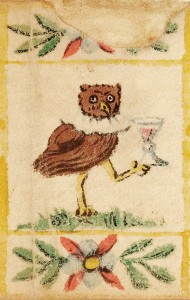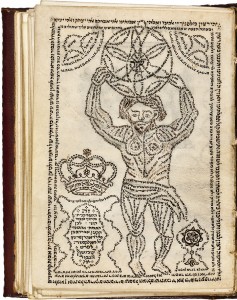Preparing for the Educational Program on the Exhibition “The Creation of the World”

Detail from a Megilla (Esther scroll), 1750-1800, Alsace
© Braginsky Collection, Zurich, photo: Ardon Bar-Hama
As a part of the educational program accompanying the exhibition “The Creation of the World: Illustrated Manuscripts from the Braginsky Collection” we’re offering the workshop “But the Snake was Craftier…” about telling and passing down stories from generation to generation. Since very few of the schoolchildren who will participate in the workshop can read Hebrew, we’ll be looking closely at the illustrations. In addition to portrayals of David with the harp and Adam and Eve in the manuscripts, our program looks at the megillot, or Esther scrolls, with their illustrations. Six scrolls have been unrolled to their full length for the exhibition.
Before we take participants in to see the exhibition, a guide will tell the story of Esther. During this conscious act of listening, each person generates pictures in his or her own mind’s eye. Afterwards, the group visits the exhibition and looks at the Esther scrolls with a magnifying glass to re-discover the scenes they’ve heard about.
To prepare for this workshop, we consulted a storytelling expert. Ten museum employees met with Prof. Dr. Kristin Wardetzky to practice storytelling under her tutelage. The first chairwoman of the Society for the Art of Storytelling, Prof. Wardetzky also founded the storytelling department at the Berlin University of the Arts’ theater education department.
Our two-day workshop with Prof. Wardetzky enthralled us all. We told stories, and we also listened a great deal to one-another – and were captivated by what we heard. We investigated the associations of individual words to learn the storyteller’s range of possibilities. There were chains of association as different as: Esther – savior – bravery – moral courage, and Esther – ashes – fasting – Ramadan. We would change the tempo, volume, and our own storytelling demeanor to the point that one small story could take on many different meanings. Try it yourself: “There was once a man who had three sons. The sons said, ‘Ah father, please tell us a story!’ So the father began, ‘There was once a man…’”
Prof. Wardetzky had us create our own stories, partly based on certain objects, partly on a mix of real experiences. This led, for example, to a story about an Israeli tourist in Saxon Switzerland who runs into a little pig that has just escaped from a factory farm. The young woman then starts a pig farm and opens a vegetarian restaurant on the mountain Pfaffenstein.

Samson the giant in microprint, Sefirat ha-Omer (Omer census), and other prayers, 1795, transcription and illustrations by Baruch ben Schemaria, Amsterdam
© Braginsky Collection, Zurich, photo: Ardon Bar-Hama
Then came the much bigger task of re-telling stories from the Bible. To prepare ourselves, we put together little booklets with texts to use as an aide-memoire (we had to look at our listeners while speaking, after all!) and with pictograms to illustrate the leitmotifs. I told the story of how Delilah complained and scolded Samson into revealing the secret of his strength. I could tell that I need more practice to make sure my little drawings will in fact serve as a memory aid.
Before we finally approached the Story of Esther, we discussed the themes and motifs of the story as well as the individual characters. We noted how little power a queen had in the Persian Empire in 500 BCE, as Achashverosh illustrated by divorcing Vashti when she refused to be paraded before the king’s guests. To what extent was Vashti acting on a conviction about her rights? Esther was afraid to speak to her husband, the king, about his vizier’s decree to exterminate the Jews – because she wasn’t allowed to approach him. She didn’t see her husband for 30 days because he didn’t summon her. Did he even love her? How could we describe King Achashverosh? Extravagant, sex-addicted, a drunkard? Dependent on his advisors?
After we had all told part of the story of Esther, it became clear: each and every one of us sees different nuances and emphases, and everyone’s storytelling style is different. But what also became clear is that storytelling is fantastic – and listening is as well!
I hope that the school children who come to hear our biblical storytelling will agree. They’ll have the chance to visit us until the beginning of August.
Diana Dressel, Education